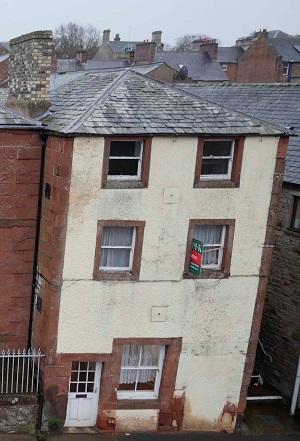Follow a real-life property renovation and learn how to make an old sandstone house #ReadyForRain.
 With regular video diaries, how-to films and on-site events, you can learn how to make a traditional stone building cosy and free from damp – even if it’s at risk of flooding, like this one.
With regular video diaries, how-to films and on-site events, you can learn how to make a traditional stone building cosy and free from damp – even if it’s at risk of flooding, like this one.
Meet 33a Chapel Street
 This three-storey terraced house in Appleby was fully refurbished in a way that makes it resilient to extreme weather, like flooding and wind-driven rain.
This three-storey terraced house in Appleby was fully refurbished in a way that makes it resilient to extreme weather, like flooding and wind-driven rain.
The owners of the property allowed CAfS to follow the renovations, so that everyone living in lovely older homes can learn about the materials and techniques that work best for insulating them and managing moisture.
We were able to bring in a professional film-maker thanks to a grant from Historic England, as part of their support for the Appleby Heritage Action Zone (HAZ).
We’re extremely grateful to the builder, Chris Morphet, for letting us follow the works he’ll be doing. It’s such a unique opportunity for us to share all his know-how.
About the house
The house dates back to the 1800s and has a solid-wall construction in red sandstone. Over the years, it’s had renovations that weren’t very sensitive to its stone fabric. It hasn’t been lived in as a home for a while, as it was most recently used by a charity.
About the build
Work got under way in August 2018. The house was gutted inside and stripped back to its bare stone walls. The roof was repaired and re-slated. The existing cement render on the front of the house was removed and the original window layout was reinstated.
It was fitted out with new flooring, electrics, plumbing and wall coverings – all using materials and methods intended to leave the house well insulated and able to manage moisture (‘breathe’) really well.
You’ll get an insight into the types of materials and building methods that are perfect for keeping older buildings warm and dry – from lime used the traditional way to newer lime-based technologies.
Given that 33a Chapel Street is also at risk of flooding, there’s also been lots of information and tips about fitting out homes so that they can cope better with extreme weather, making it quicker, cheaper and less stressful to get moved back in if it does happen again.
The challenge with older houses
Making an older house warm and comfortable is different to dealing with a modern, cavity-wall building, whether it’s at risk of extreme weather like flooding or not.
Here in Cumbria, lots of us live in solid-wall, stone buildings that can be hard to heat and suffer from damp. Often, it’s because some of the materials used on them just don’t work well for them, such as cement render. They disrupt the way these buildings are designed to manage heat and moisture.
Want to know more? Visit our section on insulating older properties >>
Find out about the house in this short introductory video by CAfS (not to be confused with the proper ones by the film-maker!)
Meet the team

This exciting film project was funded and overseen by Historic England and managed by CAfS. It was linked to the Appleby Heritage Action Zone (HAZ), which Historic England also funds (run by Eden District Council). Some additional activities like events are funded by the Lottery Fund as part of the Rebuilding Together programme to increase Cumbria’s resilience to extreme weather, which is delivered by CAfS, Cumbria CVS and ACTion with Communities in Cumbria.






